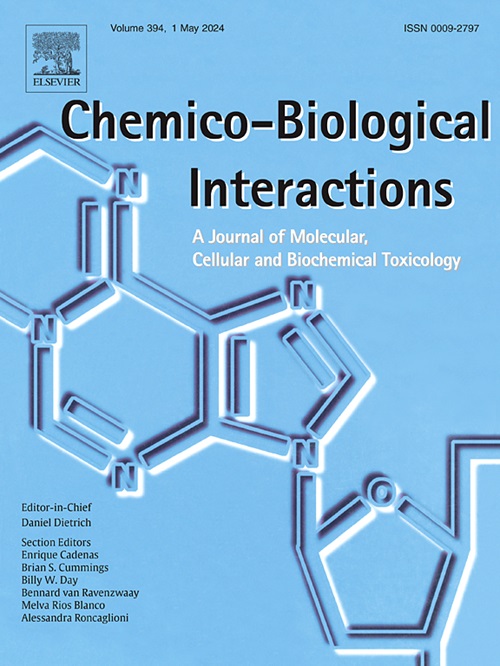Liquiritigenin通过抑制IRAK4调节MAPK (p38/JNK)信号,减轻高盐饮食诱导的慢性肾脏疾病的炎症反应、纤维化和肾功能障碍。
IF 4.7
2区 医学
Q1 BIOCHEMISTRY & MOLECULAR BIOLOGY
引用次数: 0
摘要
高盐饮食(HSD)对肾脏有不良影响,引起慢性肾脏疾病(CKD),导致肾功能障碍,通常伴有炎症反应和纤维化。本研究建立了高盐饮食对CKD雄性BALB/c小鼠肾脏损伤的体内模型,并通过灌胃利尿原(20、40和60 mg/kg)评估其保护作用。在体外NaCl (80 mM)刺激HK-2细胞的模型中,深入研究了过表达白细胞介素-1受体相关激酶4 (IRAK4)的机制,以验证利尿原素在治疗条件下的作用。结果显示,利尿原素可显著缓解高盐组大鼠体重缓慢增加,降低血清尿素氮(BUN)、血肌酐(CRE)、中性粒细胞明胶酶相关脂质转运蛋白(NGAL)、肾损伤分子-1 (KIM-1)水平,改善慢性肾损伤组织病理病变,抑制高炎症反应,恢复肾纤维化相关蛋白水平。体外实验结果显示,利尿原素显著抑制HK-2肾小管细胞中KIM-1和NGAL的表达,以及炎症因子和纤维化相关蛋白的表达。在机制上,本研究首次证明了liquiritigenin直接结合并抑制IRAK4, IRAK4是炎症信号的关键上游调节因子。通过抑制IRAK4的激活,利尿素有效地减弱了p38 MAPK和JNK通路的下游激活。这一新机制强调了利尿原素在减轻高盐诱导的肾脏炎症和纤维化方面的潜力,为CKD的治疗提供了新的治疗见解。本文章由计算机程序翻译,如有差异,请以英文原文为准。
Liquiritigenin regulates MAPK (p38/JNK) signaling through inhibition of IRAK4, attenuates inflammatory response, fibrosis and kidney dysfunction in a high-salt diet induced chronic kidney disease
High salt diet (HSD) has adverse effects on the kidneys and causes chronic kidney disease (CKD), leading to kidney dysfunction, usually accompanied by an inflammatory response and fibrosis. In the present study, an in vivo model of renal injury on a high-salt diet was established and its protective effects were assessed by gavage of liquiritigenin (20, 40 and 60 mg/kg) in CKD male BALB/c mice. An in vitro model of NaCl (80 mM) stimulated HK-2 cells and the underlying the mechanism was investigated thoroughly overexpressing Interleukin-1 Receptor-Associated Kinase 4 (IRAK4) to validate the target of liquiritigenin under therapeutic conditions. The results showed that liquiritigenin significantly alleviated the slow weight gain in the high-salt group, as well as reduced the serum levels of blood urea nitrogen (BUN), blood creatinine (CRE), neutrophil gelatinase-associated lipid transport protein (NGAL) and kidney injury molecule-1 (KIM-1) as well as ameliorated the histopathological lesions in the chronic kidney injury as well as suppressed the hyper-inflammatory response and restored the protein levels associated with renal fibrosis. In vitro experimental results showed that liquiritigenin significantly inhibited the expression of KIM-1 and NGAL in HK-2 renal tubular cells, as well as the expression of inflammatory factors and fibrosis-related proteins. Mechanistically, this study is the first to demonstrate that liquiritigenin directly binds to and inhibits IRAK4, a key upstream regulator of inflammatory signaling. By suppressing IRAK4 activation, liquiritigenin effectively attenuates downstream activation of the p38 MAPK and JNK pathways. This novel mechanism highlights the potential of liquiritigenin in mitigating high salt-induced renal inflammation and fibrosis, offering new therapeutic insights for the treatment of CKD.
求助全文
通过发布文献求助,成功后即可免费获取论文全文。
去求助
来源期刊
CiteScore
7.70
自引率
3.90%
发文量
410
审稿时长
36 days
期刊介绍:
Chemico-Biological Interactions publishes research reports and review articles that examine the molecular, cellular, and/or biochemical basis of toxicologically relevant outcomes. Special emphasis is placed on toxicological mechanisms associated with interactions between chemicals and biological systems. Outcomes may include all traditional endpoints caused by synthetic or naturally occurring chemicals, both in vivo and in vitro. Endpoints of interest include, but are not limited to carcinogenesis, mutagenesis, respiratory toxicology, neurotoxicology, reproductive and developmental toxicology, and immunotoxicology.

 求助内容:
求助内容: 应助结果提醒方式:
应助结果提醒方式:


